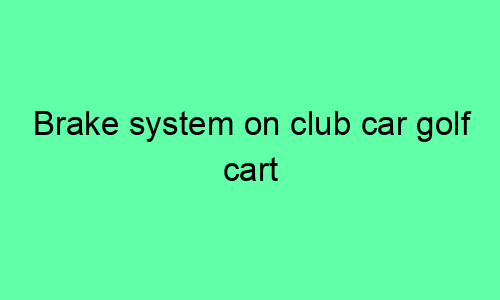Brake System on Club Car Golf Cart
Introduction
The brake system on a Club Car golf cart is a crucial component that ensures the safe operation of the vehicle. It allows the driver to slow down or stop the golf cart in a controlled manner, preventing accidents and injuries. The brake system consists of several components that work together to bring the golf cart to a halt.
Types of Brake Systems
Club Car golf carts typically come with two types of brake systems:
- Mechanical Brakes: Mechanical brakes use a system of cables and levers to apply pressure to the brake pads, which in turn slow down the wheels. They are relatively simple and cost-effective to maintain.
- Hydraulic Brakes: Hydraulic brakes utilize a fluid-filled system to transmit pressure from the brake pedal to the brake calipers. They offer better performance and control, but are more complex and require regular servicing.
Components of a Brake System
The main components of a brake system on a Club Car golf cart include:
- Brake Pedal: The brake pedal is the primary input device that initiates the braking process when pressed by the driver.
- Master Cylinder (Hydraulic Brakes): The master cylinder in a hydraulic brake system converts the mechanical force from the brake pedal into hydraulic pressure.
- Brake Lines (Hydraulic Brakes): The brake lines carry the pressurized fluid from the master cylinder to the brake calipers.
- Brake Calipers: The brake calipers house the brake pads and apply hydraulic pressure to them, causing them to clamp down on the brake rotors.
- Brake Rotors: The brake rotors are metal discs attached to the wheels that rotate with them. The brake pads rub against the rotors to create friction and slow down the wheels.
- Brake Pads: The brake pads are friction material that make contact with the brake rotors. They wear down over time and need to be replaced periodically.
How the Brake System Works
When the driver presses the brake pedal, the following sequence of events occurs:
- In mechanical brakes, the brake pedal pulls on a cable, which activates a lever that applies pressure to the brake pads.
- In hydraulic brakes, the brake pedal pushes the master cylinder piston, which pressurizes the brake fluid.
- The pressurized brake fluid travels through the brake lines to the brake calipers.
- In the brake calipers, the hydraulic pressure forces the brake pads to clamp down on the brake rotors.
- The friction between the brake pads and rotors slows down the wheels and brings the golf cart to a stop.
Maintenance and Troubleshooting
To ensure the optimal performance and safety of the brake system, regular maintenance is crucial. Here are some key maintenance tasks:
- Inspect Brake Pads: Brake pads wear down with use and should be checked regularly for wear. Replace them when they become thin or show signs of damage.
- Change Brake Fluid (Hydraulic Brakes): Brake fluid absorbs moisture over time, which can affect its performance. It should be changed according to the manufacturer’s recommendations.
- Bleed Brake Lines (Hydraulic Brakes): Air bubbles in the brake lines can reduce the system’s effectiveness. Bleed the brake lines to remove any air pockets.
- Inspect Brake Rotors: Brake rotors can develop grooves or warping over time. They should be inspected periodically and resurfaced or replaced if necessary.
If you encounter any issues with the brake system, such as reduced braking performance, noises, or vibrations, it’s important to troubleshoot the problem promptly. Consult the golf cart manufacturer’s user manual or seek professional assistance from a qualified technician.
Conclusion
The brake system on a Club Car golf cart is an essential safety component that enables the driver to control the vehicle’s speed and come to a stop. By understanding the different types, components, and maintenance requirements of a brake system, you can ensure the continued safe and reliable operation of your golf cart. Regular maintenance and prompt troubleshooting will help prevent problems and extend the life of your brake system.






